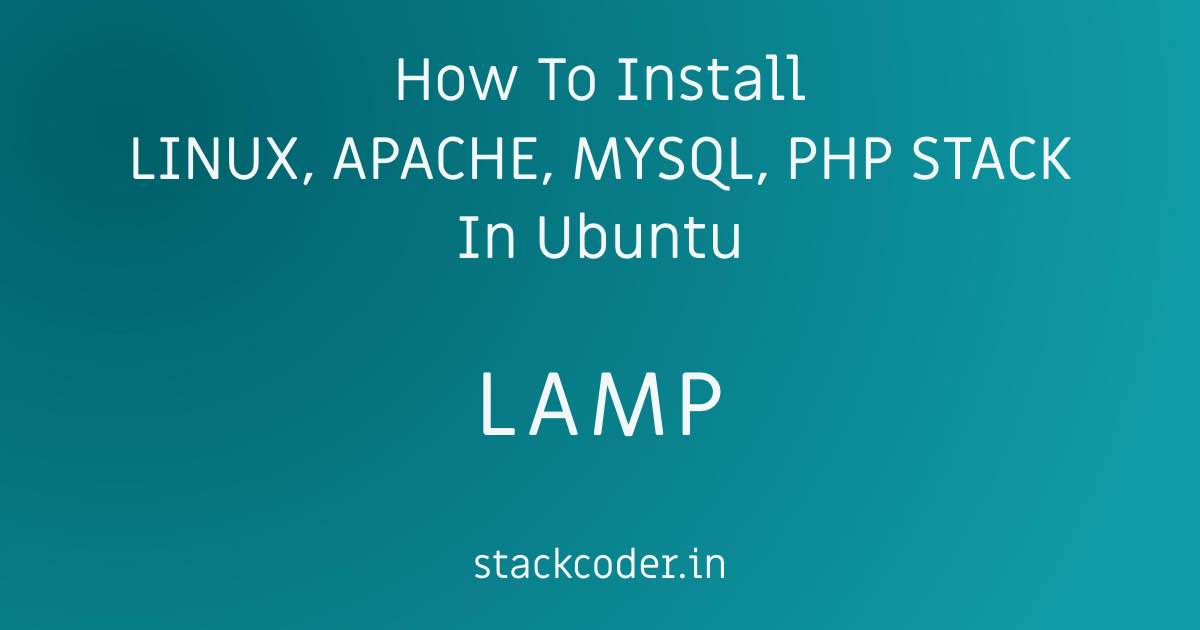
Good content takes time and effort to come up with.
Please consider supporting us by just disabling your AD BLOCKER and reloading this page again.

Install Linux, Apache, MYSQL, PHP (LAMP Stack) on Ubuntu
Hello friends in this post I am gonna show you how to install LAMP in Ubuntu server.
LAMP stands for L - LINUX, A - Apache, M - MYSQL, P - PHP
Prerequisites
Before moving ahead with this article I request you guys to setup up Ubuntu server in Digital Ocean, Linode, or any other cloud platform. If you don't have an account then click on the link and get the free credits to play around :)
If you're still using password logins or root SSH logins. Then I highly recommend you to check on How To Do Basic Server Security Setup For Ubuntu / Linux
Login to your server and follow along with the following steps.
Step 1 - Install APACHE webserver
Apache is a very famous web server in the market for decades, it handles all your server incoming requests on port 80
sudo apt-get update
sudo apt-get install apache2
To cross verify whether the installation is successful or not you can simply open your server ip_address in your browser as follows
http://your_server_ip_address
You will see a APACHE successfully installed page. Which loads from /var/www/html/ folder
Step 2 - Install the MYSQL database & secure it with a password
MYSQL is a relational database that is used to store the dynamic data and fetch the data which will come from login, register, and various other types of forms
sudo apt-get install mysql-server
Now the MYSQL database is installed. As earlier now MYSQL won't prompt for a password. So to securely install the MYSQL server use the following commands
sudo mysql_secure_installation
You might be prompted with VALIDATE PASSWORD PLUGIN please select NO as per my experiences. It will create a lot of fuss for the passwords at a later point.
By chance, if you select YES the option then you will get the following prompt
There are three levels of a password validation policy. Select difficulty based on your requirement.
LOW Length >= 8
MEDIUM Length >= 8, numeric, mixed case, and special characters
STRONG Length >= 8, numeric, mixed case, special characters and dictionary file
Please enter 0 = LOW, 1 = MEDIUM and 2 = STRONG:
Next, add the root user password and confirm the password.
New password:
Re-enter new password:
For best security practices it's a good idea to press YES for the subsequent prompts. These prompts include remove anonymous users, remove the test databases, disable remote root logins and flush privileges to save changes into effect.
By default, you will be root a user with auth_socket enabled connection. This means while connecting to the database no need for any passwords. At some point later this might cause security issues. So it's better to add the password authentication for all requesting connections.
Let me show you the same. First, let's login to MYSQL
sudo mysql
Next, run the following to see the details of the root user
SELECT user,authentication_string,plugin,host FROM mysql.user;
Once you run the above command you can see that root user doesn't have the authentication_string ie password.
Output
+------------------+-------------------------------------------+-----------------------+-----------+
| user | authentication_string | plugin | host |
+------------------+-------------------------------------------+-----------------------+-----------+
| root | | auth_socket | localhost |
To set the password run the following command, make sure to change the your_password with the valid required password
ALTER USER 'root'@'localhost' IDENTIFIED WITH mysql_native_password BY 'your_password';
Run the following command so that the changes make will take effect.
FLUSH PRIVILEGES;
Now again if you re-run the above command to check if the password is set or not then it will set with mysql_native_password. No worries if your not able to see then authentication_string as it will be encrypted by MYSQL
Output
+------------------+-------------------------------------------+-----------------------+-----------+
| user | authentication_string | plugin | host |
+------------------+-------------------------------------------+-----------------------+-----------+
| root | *549966GJ45794839F92C1571D6D78F | mysql_native_password | localhost |
Now you can safely exit from MYSQL prompt. If you try to log in as sudo mysql then it won't allow. You need to add your_password to do so.
Step 3 – Install PHP and its packages
Now you have installed APACHE webserver and MYSQL its time to set up your PHP so that your PHP scripts run.
APACHE process all your PHP scripts with the help of MOD_PHP ie PHP for APACHE module, it allows APACHE to interpret all your PHP files when any of the scripts gets called.
Now install all the PHP packages in the Ubuntu server with the following command. No need to add a specific version like the way I will do in the following command. But make sure that your local development and now installing PHP version matches else if you use composer in the future you will have to face some problems.
sudo apt install php7.4 libapache2-mod-php php7.4-mysql php7.4-curl php7.4-zip php7.4-json
If your installing LARAVEL then better to run the following command to install all packages at once
sudo apt-get install php7.4-fpm php7.4-cli php7.4-common php7.4-curl php7.4-gd php7.4-gmp php7.4-json php7.4-mbstring php7.4-mysql php7.4-xml php7.4-zip composer git zip unzip
You can add composer, zip, unzip, git in the same command instead of adding later :)
Step 4 - Setting Up PHP With APACHE Web Server
Once the PHP , MYSQL & APACHE installation is done then your left with configuring APACHE. First, you need to set up APACHE for your site. Basically, you will find all APACHE configurations in the following path
/etc/apache2/sites-available/
To check if any of these configurations are enabled or not then you need to check in the following path
/etc/apache2/sites-enabled/
Make sure to replace your_website_name.com with your domain name in the following configuration.
sudo nano /etc/apache2/sites-available/your_domain_name.com.conf
Now add the following configuration to the file. In the following, if you don't have a domain name still then just add the ip_address of your domain name.
<VirtualHost *:80>
ServerAdmin webmaster@localhost
ServerName your_domain_name.com
ServerAlias www.your_domain_name.com
DocumentRoot /var/www/html/
ErrorLog ${APACHE_LOG_DIR}/error.log
CustomLog ${APACHE_LOG_DIR}/access.log combined
</VirtualHost>
Now you have added your_domain_name.com APACHE configuration lets activate it by the following command
sudo a2ensite your_domain_name.com.conf
As a default APACHE will have 000-default.conf configuration which will be activated we have to unlink from /etc/apache2/sites-enabled/000-default.conf with the following command
sudo a2dissite 000-default.conf
Step 5- Test & restart your APACHE configuration
To test if the configuration file is working or not use the following command to check
sudo apache2ctl configtest
You will be able to see the following output
Output
Syntax OK
Now restart your APACHE server
sudo systemctl restart apache2
Step 6 - Finally check if the configuration is working
Now you have install LAMP and it's time to check if it paid your efforts. First, create testing.php file inside /var/www/html/ like /var/www/html/testing.php
sudo nano /var/www/hml/testing.php
And add the following code
<?php
echo 'LAMP installtion completed.';
Now browse URL http://website_name.com/testing.php or http://ip_address/testing.php from browser and you must be able to see the following output
LAMP installation completed.
Congrats on setting up your LAMP stack.
Conclusion
Now you know how to install the LAMP stack. If you have not read on how to perform basic server security on your sever then I highly recommend reading my article on it
How To Do Basic Server Security Setup For Ubuntu / Linux
Articles For You
Lazy Load YouTube And Other Videos In Website
Relationship Table Data With Route Model Binding In Laravel
Laravel 7.x Multiple Database Connections, Migrations, Relationships & Querying
Resolve 404 Not Found In NGINX
Run Raw Queries Securely In Laravel
Create A Composer Package? Test It Locally And Add To Packagist Repository
Setup AMP (Accelerated Mobile Pages) In PHP Laravel
Unable to prepare route [{fallbackPlaceholder}] for serialization. Uses Closure In Laravel
Firebase Cloud Messaging (FCM) Browser Web Push Notifications Using Javascript And PHP
Add Google ADS In AMP (Accelerated Mobile Pages) Website
Facebook Login With PHP Laravel Socialite







